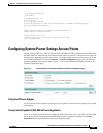
4-27
Cisco IOS Software Configuration Guide for Cisco Aironet Access Points
OL-30644-01
Chapter 4 Configuring the Access Point for the First Time
Configuring the 802.1X Supplicant
ap1240AG>enable
Password:xxxxxxx
ap1240AG#config terminal
Enter configuration commands, one per line. End with CTRL-Z.
ap1240AG(config)# dot1x credentials test
ap1240AG(config-dot1x-creden)#username Cisco
ap1240AG(config-dot1x-creden)#password Cisco
ap1240AG(config-dot1x-creden)#exit
ap1240AG(config)#
Applying the Credentials to an Interface or SSID
Credential profiles are applied to an interface or an SSID in the same way.
Applying the Credentials Profile to the Wired Port
Beginning in the privileged EXEC mode, follow these steps to apply the credentials to the access point
wired port:
The following example applies the credentials profile test to the access point gigabit Ethernet port:
ap1240AG>enable
Password:xxxxxxx
ap1240AG#config terminal
Enter configuration commands, one per line. End with CTRL-Z.
ap1240AG(config)#interface Gig0
ap1240AG(config-if)#dot1x credentials test
ap1240AG(config-if)#end
ap1240AG#
Applying the Credentials Profile to an SSID Used For the Uplink
If you have a repeater access point in your wireless network and are using the 802.1X supplicant on the
root access point, you must apply the 802.1X supplicant credentials to the SSID the repeater uses to
associate with and authenticate to the root access point.
Beginning in the privileged EXEC mode, follow these steps to apply the credentials to an SSID used for
the uplink:
Command Purpose
Step 1
configure terminal Enter global configuration mode.
Step 2
interface gigabitethernet 0 Enter the interface configuration mode for the access point
Gigabit Ethernet port.
Note You can also use interface fa0 to enter the Gigabit
Ethernet configuration mode.
Step 3
dot1x credentials profile name Enter the name of a previously created credentials profile.
Step 4
end Return to the privileged EXEC mode
Step 5
copy running config
startup-config
(Optional) Save your entries in the configuration file.


















